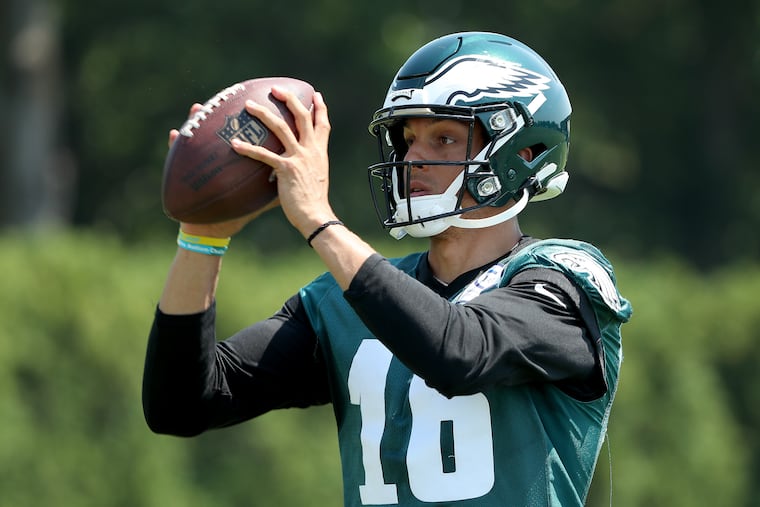Eagles wide receiver Mack Hollins’ latest injury is hurting his chances of making the team
After missing last season with two groin tears, the receiver is hurt again.

This is how quickly things can change in professional football.
A year ago, Mack Hollins figured to be an important part of the Eagles offense going forward. The 6-foot-4, 221-pound wide receiver was coming off an impressive rookie season in 2017 in which he averaged 14.1 yards per catch, the highest catch average by an Eagles rookie since DeSean Jackson nearly a decade earlier.
Then Hollins got hurt, suffering two groin tears that sidelined him for the entire 2018 season. Out of sight, out of mind.
A week into his third training camp, life has changed dramatically for Hollins. He’s now just another guy fighting for a roster job. And he’s doing that with his hands tied behind his back because he’s hurt again.
Hollins suffered a lower-body injury, believed to be a hamstring strain, in warmups earlier this week, and that has kept him out of the last four training camp practices.
Coach Doug Pederson said Thursday that he thinks Hollins will be back “maybe in the next few days, at least [participating in] individual [drills] and some seven-on-seven stuff.’’
While he obviously is frustrated to be sidelined again, Hollins found some solace in the fact that he at least didn’t reinjure his groin.
“I’m just super happy that it’s not the groin,’’ he said earlier this week. “It’s not the same thing where we’re back to where we were a year ago, and then it lingers and I’m not able to play in the preseason. Mentally, I don’t know if I could do that again.’’
While Hollins wasn’t able to practice this week, he caught about 300 balls from the JUGS machine every day after practice.
“If last year taught me anything, it’s how to get my work in even when I’m not practicing,’’ he said. “If I can’t run right now, then I’m going to make up for it with my hands.
“But [the injury] is already getting better. I can run around and do the deeper stuff and jump. Now it’s just a matter of being smart and not rushing it.’’
That can be difficult to do when you know that every practice you miss might impact your chances of making the team.
The Eagles are going to keep no more than six wide receivers and, quite possibly, only five. Four of those spots already are the property of Alshon Jeffery, Nelson Agholor, DeSean Jackson, and second-round rookie J.J. Arcega-Whiteside.
Hollins is battling several other wideouts, including Greg Ward Jr., Charles Johnson and Marken Michel, for the one or two vacancies that remain.
One thing that Hollins has going for him is that bottom-of-the-roster players need to be able to play special teams, and he’s an exceptional special teams player. He was considered one of the top special teams players in the ’17 draft, and had five special teams tackles as a rookie.
“It’s hard to watch your teammates dying in the heat and not be out there with them,’’ he said. “Obviously, I want to go whether I can or not.’’
When the Eagles selected the University of North Carolina product in the fourth round of the ‘17 draft, his size was a big part of his appeal.
But with the 6-2, 225-pound Arcega-Whiteside joining the 6-3, 225-pound Jeffery, they might not feel they absolutely need another big wideout, which could favor a smaller, more versatile receiver such as the 5-11, 190-pound Ward.
Last year was pure hell for Hollins. He tore one side of his groin in the offseason, had sports hernia surgery, then returned in time for training camp.
But then, at some point during the summer, he tore the other side. He played in the Eagles’ first preseason game before being shut down. He had a second surgery and was placed on injured reserve before the season.
“As a competitor, it’s just so tough,’’ Hollins said. “It’s like if you guys [reporters] couldn’t report for a year. But you’re right outside the gate. You can look in, but you can’t ask any questions or get any information. It sucks. It really does. You’re so close, but so far away.’’
The Eagles had the option to activate Hollins later in the year after he was healthy again, but chose not to. Hollins felt like an invisible man in the locker room and meeting rooms.
“When you’re hurt, you don’t have that same relationship with guys,’’ Hollins said. “I could’ve played 10 years on the team. But as soon as those pads come off, it’s not the same.
“You can tell a guy, ‘Hey, you need to do this and this.’ But you’re not sweating with him. You’re not feeling the same heat. You can tell me how you used to do it, but it’s not the same.’’